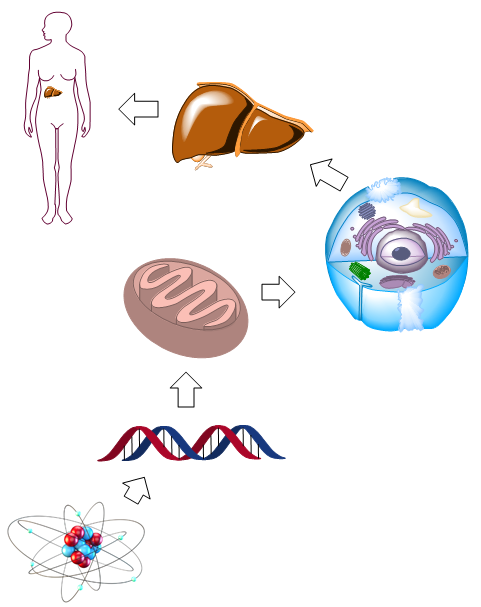The enormous diversity of life that exists in nature makes it challenging to answer this question. However, from a biochemical perspective, all living beings behave in a similar manner and obey the same physical and chemical laws. Both a whale and a small microorganism are composed of the same molecules and share numerous biochemical processes.
 Hierarchical Organization of Multicellular Organisms: Let's examine the main characteristics that define life:
Hierarchical Organization of Multicellular Organisms: Let's examine the main characteristics that define life:
- All living organisms are primarily composed of organic molecules, many of which exhibit high complexity and three-dimensional shapes that determine their function. Life is based on thousands of chemical reactions that occur between these biomolecules and are responsible for vital processes such as growth.
- Living beings are organized into a series of hierarchical levels, and at each level, new properties emerge that did not exist in the previous levels. The most basic level consists of subatomic particles, which form atoms that, in turn, combine to form small biomolecules (amino acids, sugars, nucleotides, etc.). At the next hierarchical level, biomolecules join together to form macromolecules (proteins, nucleic acids, polysaccharides), which can further combine to form even larger structures called supramolecular structures. These supramolecular structures associate to form organelles that make up the cell. In the case of multicellular organisms, there is a higher hierarchy formed by the union of millions of cells, which give rise to organs.
- As we ascend the different levels of organization, new properties emerge that could not be predicted at the previous levels. A visual example of how properties change as we ascend through different levels can be found in iron within hemoglobin. Isolated iron oxidizes in the presence of oxygen; however, the heme group protects it from this oxidation. The properties of iron change when it becomes part of the protein complex. As we ascend the hierarchical levels, new properties emerge that did not exist in the previous levels.
- To maintain a high level of organization and order, living beings are compelled to continuously process matter, expelling waste products in turn. These tasks are carried out through biochemical reactions catalyzed by enzymes. The set of reactions that take place in a living being is called metabolism.
- The cell is composed of organelles enclosed by a cell membrane, which regulates the flow of matter between the interior and exterior of the cell, as well as the cell's response to the extracellular environment. When a cell is divided into its constituents, vital processes cease. Therefore, we can say that the cell is the lowest hierarchical level that exhibits life. On Earth, a cell can only arise from the division of another cell; there is no process that can create a cell from its elemental constituents.
- Life is sustained by the information contained in DNA. The nucleotide sequence of this macromolecule contains the necessary information to synthesize all the proteins required by the cell. Each protein is encoded in a DNA fragment called a gene. When a gene is activated, it transcribes its information into an RNA molecule, which, in turn, translates this information into a protein in the ribosomes. Proteins have a three-dimensional shape that allows them to interact specifically with other molecules that have a complementary spatial shape, and through this interaction, information is transferred.
- An example of information transfer can be found in the interaction between the insulin molecule and receptors present on certain cells' cell membranes. This binding is the signal that indicates to the cell the start of glucose uptake from the extracellular environment.
- Life is in a constant state of evolution and adaptation to the environment. All life on Earth comes from a common ancestor. Diversity and evolution originate from errors that occur during the copying of DNA molecules, known as mutations. Most of these errors are silent, meaning they are either repaired by the cell or have no effect on its function. Other mutations are harmful and reduce the chances of reproduction, causing individuals carrying them to eventually disappear. However, there are mutations that allow organisms to better adapt to the environment, and these individuals reproduce more effectively, leading to population growth. The accumulation of mutations over many generations can give rise to very different forms of life. These life forms continue to adapt to environmental conditions and improve their capabilities to exploit available energy sources.

